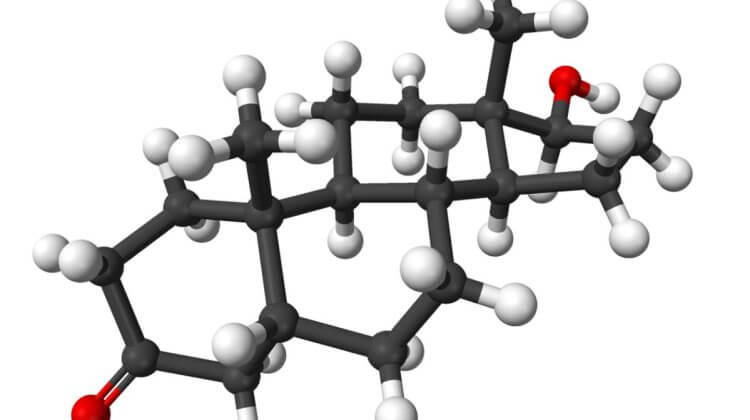
The main androgen secreted by the testes is of course testosterone. However, in most of the body, the androgenic signal is not carried through by testosterone. In these tissues, which include the brain (CNS), skin, genitals – practically everything but muscle – the active androgen is actually dihydrotestosterone (DHT). Testosterone in this case simply acts as a prohormone that is converted to the active androgen DHT by the action of the enzyme 5alpha reductase (5-AR).
5-AR is concentrated heavily in practically every androgen dependent area of the body except for skeletal muscle. This results in very little testosterone actually getting through to these parts of the body to bind to androgen receptors. Instead, it is quickly transformed into DHT, which then interacts with receptors.
This transformation serves a very important biological function in these tissues. You see, dihydrotestosterone is a much stronger androgen than testosterone – it binds about 3-5 times more strongly to the androgen receptor. If you took away 5-AR from these tissues and blocked the formation of DHT, then you would see some dramatic changes in physiology.
A good case in point is demonstrated in male pseudohermaphroditism due to congenital 5-AR deficiency. This is a relatively rare disorder, however it is actually quite common in the Dominican Republic. In this disorder, males are born with little or no 5-AR enzyme. They have ambiguous genitalia and are often raised as girls. When puberty occurs, their testosterone levels elevate normally although their DHT levels remain very low. Their musculature develops normally like that of other adults, however, they end up with little or no pubic / body hair and underdeveloped prostate and penis. Their libido and sexual function is often disrupted also.
Testosterone is the active androgen in muscle
Skeletal muscle is unique from other androgen dependent tissues in the body. It actually contains little or no 5-AR, so little or no DHT is actually formed in the muscle. In addition to this, any DHT that is formed, or that is already present in the blood and travels to the muscle, is quickly deactivated by an enzyme called 3alpha-hydroxysteroid reductase (3a-HSD).
So at least as far as muscle is concerned, testosterone is the primary active androgen. This is not to say that administering exogenous DHT is not without any anabolic effect. It actually does have some anabolic activity in the muscle, albeit significantly weaker than that of an equal amount of testosterone. This is due to its quick breakdown by 3a-HSD into the weak metabolite 5alpha-androstan-3a,17b-diol. If this enzyme were somehow blocked, it is likely that DHT would exhibit very potent anabolic effects on muscle.
It is important to understand that even though testosterone is the active androgen in muscle, and DHT exhibits relatively little direct anabolic effects on muscle in men, DHT is still very important for the full performance enhancement effects from testosterone. What I specifically mean here are the effects of DHT on the central nervous system, which lead to increased neurological efficiency (strength), and increased resistance to psychological and physical stress – not to mention optimal sexual function and libido.
I have heard several anecdotal reports of individuals who have stacked testosterone with Proscar (a 5-AR inhibitor) and have noticed significantly reduced performance enhancement effects. What’s going on here? We know it couldn’t be due to the inhibition of the direct anabolic activity of testosterone on muscle anabolism. Most likely it is due to the reduction of androgenic effects in other parts of the body that contribute to the ergogenic effects, specifically the CNS, which is stimulated by androgens to increase neural output leading to greater strength and greater recoverability. Another possibility is a reduction in the production of androgen dependent liver growth factors (such as IGF-1), since DHT is an important androgen in the liver.
Anti–Estrogen effects of DHT
One important function of DHT in the body that does not get much discussion is its antagonism of estrogen. Some men that take Proscar learn this the hard way – by developing a case of gynecomastia. By reducing DHT’s protection against estrogen in the body, these men have fallen victim to its most dreaded ramification – bitch tits!
How does DHT protect against estrogen? There are at least three ways that this likely occurs. First of all, DHT directly inhibits estrogens activity on tissues. It either does this by acting as a competitive antagonist to the estrogen receptor or by decreasing estrogen-induced RNA transcription at a point subsequent to estrogen receptor binding.
Second of all, DHT and its metabolites have been shown to directly block the production of estrogens from androgens by inhibiting the activity of the aromatase enzyme. The studies done in breast tissue showed that DHT, androsterone, and 5alpha-androstandione are potent inhibitors of the formation of estrone from androstenedione. 5alpha-androstandione was shown to be the most potent, while androsterone was the least.
Lastly, DHT acts on the hypothalamus / pituitary to decrease the secretion of gonadotropins. By decreasing the secretion of gonadotropins you decrease the production of the raw materials for estrogen production – testosterone and androstenedione (DHT itself cannot aromatize into estrogens).
About the author
Patrick Arnold, widely considered the "father of prohormones", is an organic chemist known for introducing androstenedione, 1-androstenediol, and methylhexanamine into the dietary supplement market. He became infamous for creating the designer steroid tetrahydrogestrinone, also known as THG and "the clear".
Arnold manufactured THG, norbolethone and desoxymethyltestosterone (DMT) for athletes in the BALCO doping scandal. The designer steroids, which were legal at the time of their creation, were difficult for anti-doping authorities to detect.
